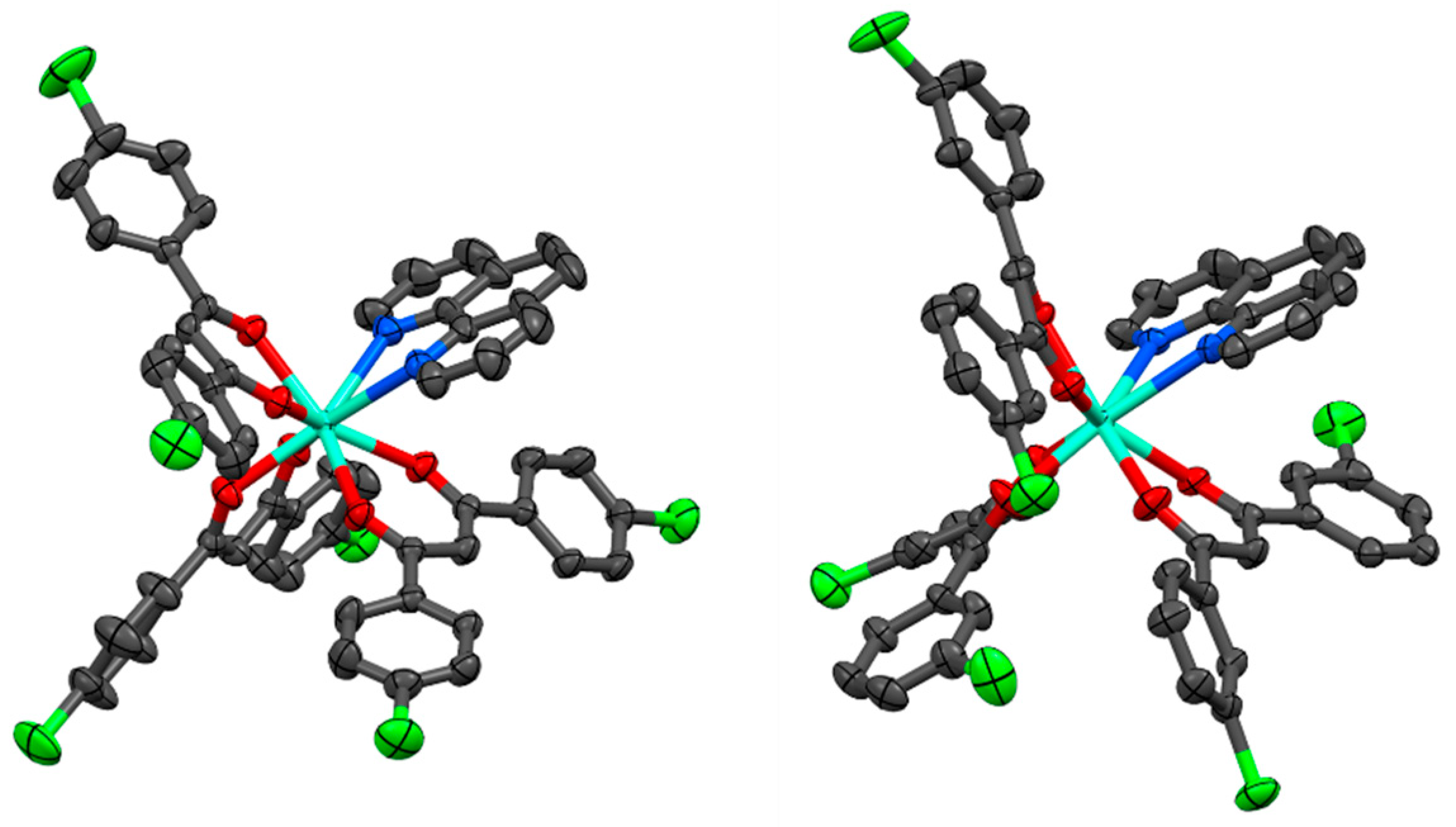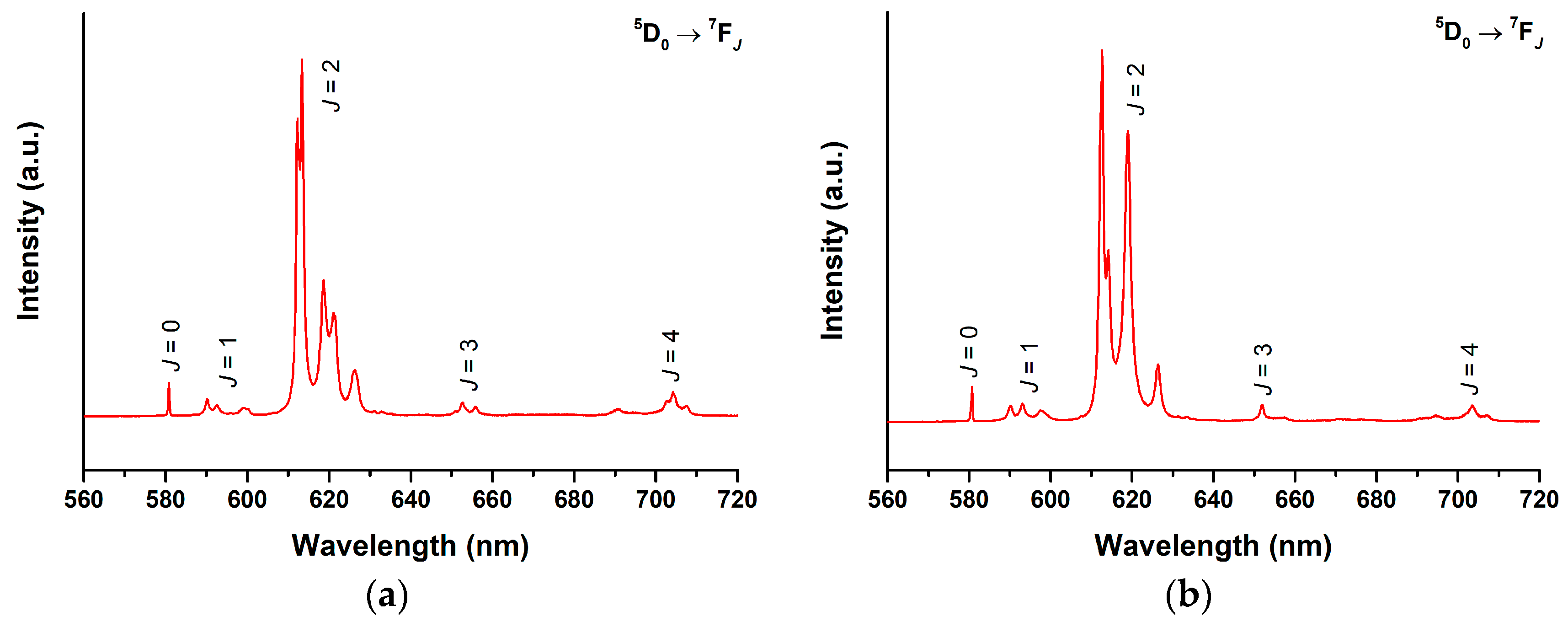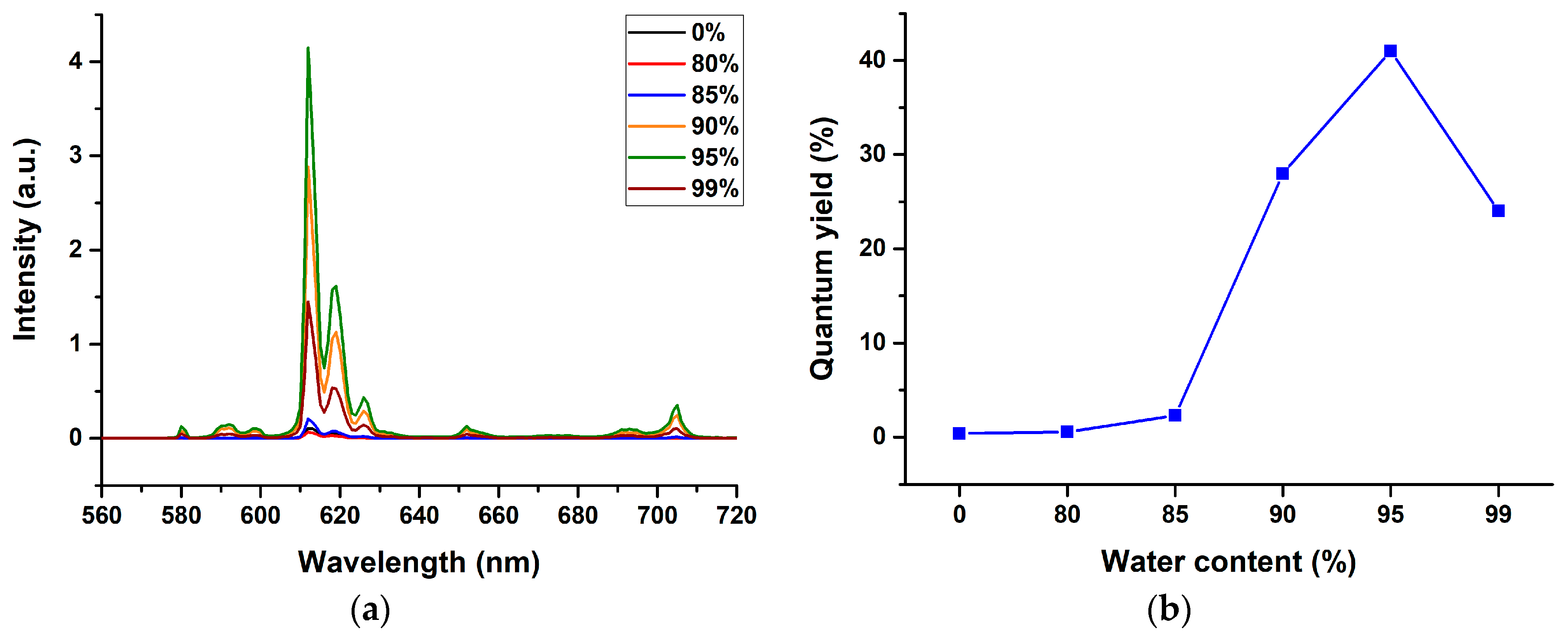Triboluminescence of Centrosymmetric Lanthanide β-Diketonate Complexes with Aggregation-Induced Emission
Abstract
:1. Introduction
2. Results and Discussion
2.1. Synthesis and Characterization
2.2. Luminescent Properties
2.3. Tribolumimescence and Molecular Packing
3. Experimental
3.1. Material Preparation
3.2. Synthesis of Ligands and Complexes
3.3. Characterization Measurement
3.4. Single Crystal Structure Determination
3.5. Photophysical Measurement
4. Conclusions
Supplementary Materials
Author Contributions
Funding
Acknowledgments
Conflicts of Interest
References
- Walton, A.J. Triboluminescence. Adv. Phys. 1977, 26, 887–948. [Google Scholar] [CrossRef]
- Peng, D.; Chen, B.; Wang, F. Recent advances in doped mechanoluminescent phosphors. Chem. Plus Chem. 2015, 80, 1209–1215. [Google Scholar] [CrossRef]
- Chen, X.F.; Zhu, X.H.; Xu, Y.H.; Shanmuga Sundara Raj, S.; Öztürk, S.; Fun, H.K.; Ma, J.; You, X.Z. Triboluminescence and crystal structures of nonionic europium complexes. J. Mater. Chem. 1999, 9, 2919–2922. [Google Scholar] [CrossRef]
- Wong, H.Y.; Lo, W.S.; Chan, W.T.K.; Law, G.L. Mechanistic investigation of inducing triboluminescence in lanthanide(III) β-diketonate complexes. Inorg. Chem. 2017, 56, 5135–5140. [Google Scholar] [CrossRef] [PubMed]
- Chen, X.-F.; Liu, S.-H.; Duan, C.-Y.; Xu, Y.-H.; You, X.-Z.; Ma, J.; Min, N.-B. Synthesis, crystal structure and triboluminescence spectrum of 1,4-dimethylpyridinium tetrakis (2-thenoyltrifluoroacetonato)europate. Polyhedron 1998, 17, 1883–1889. [Google Scholar] [CrossRef]
- Chen, X.-F.; Duan, C.-Y.; Zhu, X.-H.; You, X.-Z.; Shanmuga Sundara Raj, S.; Fun, H.-K.; Wu, J. Triboluminescence and crystal structures of europium(III) complexes. Mater. Chem. Phys. 2001, 72, 11–15. [Google Scholar] [CrossRef]
- Rheingold, A.L.; King, W. Crystal structures of three brilliantly triboluminescent centrosymmetric lanthanide complexes: piperidinium tetrakis(benzoylacetonato)europate, hexakis(antipyrine)terbium triiodide, and hexaaquadichloroterbium chloride. Inorg. Chem. 1989, 28, 1715–1719. [Google Scholar] [CrossRef]
- Sweeting, L.M. Triboluminescence with and without air. Chem. Mater. 2001, 13, 854–870. [Google Scholar] [CrossRef]
- Moore, E.G.; Samuel, A.P.; Raymond, K.N. From antenna to assay: Lessons learned in lanthanide luminescence. Acc. Chem. Res. 2009, 42, 542–552. [Google Scholar] [CrossRef] [PubMed]
- Eliseeva, S.V.; Bünzli, J.C. Lanthanide luminescence for functional materials and bio-sciences. Chem. Soc. Rev. 2010, 39, 189–227. [Google Scholar] [CrossRef]
- Xie, Y.; Li, Z. Triboluminescence: Recalling interest and new aspects. Chem 2018, 4, 943–971. [Google Scholar] [CrossRef]
- Thilagar, P.; Mukherjee, S. Renaissance of organic triboluminescent materials. Angew. Chem. Int. Ed. Engl. 2018. accepted article. [Google Scholar]
- Liu, F.; Tu, J.; Wang, X.; Wang, J.; Gong, Y.; Han, M.; Dang, X.; Liao, Q.; Peng, Q.; Li, Q.; et al. Opposite mechanoluminescence behavior of two isomers with different linkage positions. Chem. Commun. 2018, 54, 5598–5601. [Google Scholar]
- Mei, J.; Leung, N.L.; Kwok, R.T.; Lam, J.W.; Tang, B.Z. Aggregation-induced emission: Together we shine, united we soar! Chem. Rev. 2015, 115, 11718–11940. [Google Scholar] [CrossRef] [PubMed]
- Sheet, S.K.; Sen, B.; Patra, S.K.; Rabha, M.; Aguan, K.; Khatua, S. Aggregation-induced emission-active ruthenium(II) complex of 4,7-dichloro phenanthroline for selective luminescent detection and ribosomal RNA imaging. ACS Appl. Mater. Interfaces 2018, 10, 14356–14366. [Google Scholar] [CrossRef] [PubMed]
- Xu, J.; Radkov, E.; Ziegler, M.; Raymond, K.N. Plutonium(IV) sequestration: Structural and thermodynamic evaluation of the extraordinarily stable cerium(IV) hydroxypyridinonate complexes. Inorg. Chem. 2000, 39, 4156–4164. [Google Scholar] [CrossRef] [PubMed]
- Daumann, L.J.; Tatum, D.S.; Andolina, C.M.; Pacold, J.I.; D’Aleo, A.; Law, G.L.; Xu, J.; Raymond, K.N. Effects of ligand geometry on the photophysical properties of photoluminescent Eu(III) and Sm(III) 1-hydroxypyridin-2-one complexes in aqueous solution. Inorg. Chem. 2016, 55, 114–124. [Google Scholar] [CrossRef] [PubMed]
- Zhang, G.; Zhu, H.; Chen, M.; Pietraszkiewicz, M.; Pietraszkiewicz, O.; Li, H.; Hao, J. Aggregation-induced emission of Eu(III) complexes balanced with bulky and amphiphilic imidazolium cations in ethanol/water binary mixtures. Chem. Eur. J. 2018, 24, 15912–15920. [Google Scholar] [CrossRef] [PubMed]
- Hirai, Y.; Nakanishi, T.; Kitagawa, Y.; Fushimi, K.; Seki, T.; Ito, H.; Hasegawa, Y. Triboluminescence of lanthanide coordination polymers with face-to-face arranged substituents. Angew. Chem. Int. Ed. Engl. 2017, 56, 7171–7175. [Google Scholar] [CrossRef] [PubMed]
- Zink, J.I. Triboluminescence. Acc. Chem. Res. 2002, 11, 289–295. [Google Scholar] [CrossRef]
Sample Availability: Samples of the compounds [Eu(pp-dbm-Cl2)3phen] and [Eu(mm-dbm-Cl2)3phen] are available from the authors. |









© 2019 by the authors. Licensee MDPI, Basel, Switzerland. This article is an open access article distributed under the terms and conditions of the Creative Commons Attribution (CC BY) license (http://creativecommons.org/licenses/by/4.0/).
Share and Cite
Wong, H.-Y.; Chan, W.T.K.; Law, G.-L. Triboluminescence of Centrosymmetric Lanthanide β-Diketonate Complexes with Aggregation-Induced Emission. Molecules 2019, 24, 662. https://doi.org/10.3390/molecules24040662
Wong H-Y, Chan WTK, Law G-L. Triboluminescence of Centrosymmetric Lanthanide β-Diketonate Complexes with Aggregation-Induced Emission. Molecules. 2019; 24(4):662. https://doi.org/10.3390/molecules24040662
Chicago/Turabian StyleWong, Ho-Yin, Wesley Ting Kwok Chan, and Ga-Lai Law. 2019. "Triboluminescence of Centrosymmetric Lanthanide β-Diketonate Complexes with Aggregation-Induced Emission" Molecules 24, no. 4: 662. https://doi.org/10.3390/molecules24040662






